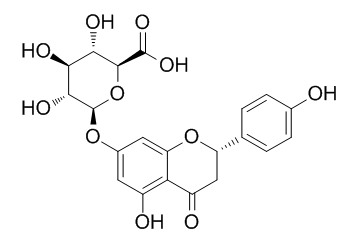Naringenin-7-O-beta-D-glucuronide
Reference standards.
Inquire / Order:
manager@chemfaces.com
Technical Inquiries:
service@chemfaces.com
Tel:
+86-27-84237783
Fax:
+86-27-84254680
Address:
1 Building, No. 83, CheCheng Rd., Wuhan Economic and Technological Development Zone, Wuhan, Hubei 430056, PRC
Providing storage is as stated on the product vial and the vial is kept tightly sealed, the product can be stored for up to
24 months(2-8C).
Wherever possible, you should prepare and use solutions on the same day. However, if you need to make up stock solutions in advance, we recommend that you store the solution as aliquots in tightly sealed vials at -20C. Generally, these will be useable for up to two weeks. Before use, and prior to opening the vial we recommend that you allow your product to equilibrate to room temperature for at least 1 hour.
Need more advice on solubility, usage and handling? Please email to: service@chemfaces.com
The packaging of the product may have turned upside down during transportation, resulting in the natural compounds adhering to the neck or cap of the vial. take the vial out of its packaging and gently shake to let the compounds fall to the bottom of the vial. for liquid products, centrifuge at 200-500 RPM to gather the liquid at the bottom of the vial. try to avoid loss or contamination during handling.
Korean J of Medicinal Crop Science2018, 220-226
Biomol Ther (Seoul).2020, 28(6):542-548.
Int J Mol Med.2015, 35(5):1237-45
Cancer Manag Res.2019, 11:483-500
Chemistry of Plant Materials.2019, 129-136
Ajou University2024, 4688116
Antioxidants (Basel).2020, 9(6):466.
J Ethnopharmacol.2024, 333:118415.
Int Immunopharmacol.2021, 100:108073.
Int J Mol Sci.2018, 19(9):E2825
Related and Featured Products
J Agric Food Chem. 2009 Jul 22;57(14):6432-7.
Identification and quantification of metabolites of orally administered naringenin chalcone in rats.[Pubmed:
19558184]
Naringenin chalcone is the main active component of tomato skin extract, which has an antiallergic activity.
METHODS AND RESULTS:
In this study, naringenin chalcone was orally administered to rats, and the chemical structures and levels of the major metabolites in the plasma and urine of rats were determined. HPLC analysis indicated the presence of three major metabolites in the urine. LC-MS and NMR analyses tentatively identified these as naringenin chalcone-2'-O-beta-D-glucuronide, Naringenin-7-O-beta-D-glucuronide, and naringenin-4'-O-beta-D-glucuronide. Naringenin chalcone-2'-O-beta-D-glucuronide was the only metabolite detected in the plasma, and its peak plasma level was observed 1 h after naringenin chalcone administration. Naringenin chalcone-2'-O-beta-D-glucuronide also inhibited histamine release from rat peritoneal mast cells stimulated with compound 48/80.
CONCLUSIONS:
This activity might contribute to the antiallergic activity of naringenin chalcone in vivo. To the best of the authors' knowledge, this study is the first to report determination of naringenin chalcone metabolites in rat plasma and urine.
Int J Food Sci Nutr. 2013 Nov;64(7):843-9.
Effects of naringenin and its phase II metabolites on in vitro human macrophage gene expression.[Pubmed:
23883170 ]
Naringenin, together with its glycosidic forms, is a flavanone abundant in grapefruit and orange. It has been detected in human plasma, following citrus juice intake, at sub-μmolar concentrations, and its main phase II conjugated metabolites (naringenin-7-O-glucuronide(Naringenin-7-O-beta-D-glucuronide) and narigenin-4'-O-glucuronide) have been identified in urine.
Recent evidence suggests a potential active anti-inflammatory role of flavonoids on macrophages, cells actively involved in atherogenesis.
The aim of this study was to evaluate the effects of naringenin and its phase II metabolites on the expression of specific genes in differently activated macrophages at concentrations coherent with dietary exposure.
METHODS AND RESULTS:
Results suggest that phase II metabolites, as well as the aglyconic form of naringenin, were able to perturb macrophage gene expression in directions that are not always consistent with anti-inflammatory effects. Moreover, the effects of metabolites were not always consistent with each other and with those of their aglycone, underlining the paramount importance of testing physiological forms of phytochemicals within in vitro experimental models.
In vivo studies are needed to further explore these observations and investigate their practical consequences.



